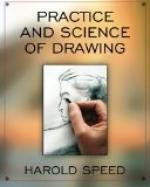It is here that the photograph fails, it can only at best give mechanical accuracy, whereas art gives the impression of a live, individual consciousness. Where the recording instrument is a live individual, there is no mechanical standard of accuracy possible, as every recording instrument is a different personality. And it is the subtle differences in the individual renderings of nature that are the life-blood of art. The photograph, on account of its being chained to mechanical accuracy, has none of this play of life to give it charm. It only approaches artistic conditions when it is blurred, vague, and indefinite, as in so-called artistic photography, for then only can some amount of this vitalising play, this “dither” be imagined to exist.
It is this perfect accuracy, this lack of play, of variety, that makes the machine-made article so lifeless. Wherever there is life there is variety, and the substitution of the machine-made for the hand-made article has impoverished the world to a greater extent than we are probably yet aware of. Whereas formerly, before the advent of machinery, the commonest article you could pick up had a life and warmth which gave it individual interest, now everything is turned out to such a perfection of deadness that one is driven to pick up and collect, in sheer desperation, the commonest rubbish still surviving from the earlier period.
But to return to our drawings. If the variations from strict accuracy made under the influence of feeling are too great, the result will be a caricature. The variations in a beautiful drawing are so subtle as often to defy detection. The studies of Ingres are an instance of what I mean. How true and instinct with life are his lines, and how easily one might assume that they were merely accurate. But no merely accurate work would have the impelling quality these drawings possess. If the writer may venture an opinion on so great an artist, the subtle difference we are talking about was sometimes missed by even Ingres himself, when he transferred his drawings to the canvas; and the pictures have in some cases become academic and lifeless. Without the stimulus of nature before him it was difficult to preserve the “dither” in the drawing, and the life has escaped. This is the great difficulty of working from studies; it is so easy to lose those little points in your drawing that make for vitality of expression, in the process of copying in cold blood.
[Illustration: Plate XV.
FROM A PENCIL DRAWING BY INGRES
Photo Bulloz]
The fact is: it is only the academic that can be taught. And it is no small thing if this is well done in a school. The qualities that give vitality and distinction to drawing must be appreciated by the student himself, and may often assert themselves in his drawing without his being aware that he is doing aught but honestly copying. And if he has trained himself thoroughly he will not find much difficulty when he is moved to vital expression. All the master can do is to stand by and encourage whenever he sees evidence of the real thing. But there is undoubtedly this danger of the school studies becoming the end instead of the means.




